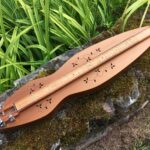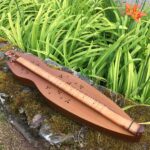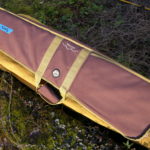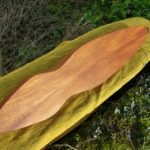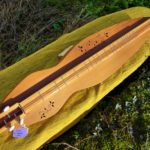2.317 June 2007 Yocky 4 String 3 Course Hourglass £Sold
Handwritten on dulcimer top under tuning pegs and within the ‘pegbox’: “Tom Yocky Jr./ 6-14-07/ ‘Enchant’.” The signature Yocky design of a long, large body with the ‘pegbox’/head mounted on top. The body has mahogany-like sides, a ‘butternut’ (?) bookmatched back with mahogany central purfling and a dark cedar top with small soundholes in a flower design. The ‘head’ and ‘tail’ of the body are near-identical mahogany prows, the latter with holes for ball end strings. The hollow fingerboard is made from a sandwich of 5 woods, including mahogany and maple. 6+ and 13+ frets with black markers at frets 5, 7, 9, 12 & 15 (?!). The bridge and nut are thin ebony inserts, slotted for 3 course or 4 equidistant string layouts. Tuners are decent quality chrome, enclosed Schaller-lookalikes – Ping? Two heavier dings on the n/s top edge and several smaller ones on the f/s. Overall length 34¼”, upper bout 6⅝”, lower bout 7¼”, depth 2¼”, FBW 1¾”, VSL 27½” (medium scale), weight 2lb 0oz (918g), strings 11/[11], 15, 24w. Has a 6+ and 13+fret.
Clever design to achieve compact overall length with large volume body, though the aesthetic outcome might divide opinion. This has an attractively large, open sound with an easy action. No boominess and very clear note articulation. A classy dulcimer for progressing advanced players.
Click on thumbnails below to enlarge.
2.96 – Tom Yocky 2005 – 4 String Hourglass – £Sold inc. original soft padded case
Individually named dulcimer from an original US dulcimer-making talent. Handwritten within “pegbox”: “Tom Yocky Jr./ 10-2-05/ ‘Reaching’.” Tom Yocky decided to take an important evolutionary step in mountain dulcimer design some 10 years ago. Instead of a 29”/30” body with a 5” long head (pegbox/scroll) extending from it, he made the body 35”/36” long and mounted the “pegbox” and fingerboard on top of it. The resulting design is streamlined and provides significant advantages in terms of sound (big volume of moving air), but comprises an unusual, long tapering hourglass body which is not to everyone’s taste.
Mahogany sides and (bookmatched) back with redwood or western red cedar top, with soundholes to far LB and near UB which are decorated with small vines leaves. Tall mahogany head and tail blocks make it look rather like a double-ended boat. The “pegbox” and fingerboard are in one piece and mounted directly on the soundboard, but comprise a light, box-shaped cross section made from a 5 piece lamination. The dulcimer has 6+ and 13+ frets with dark wood markers at frets 5, 7, 9, 12 and 15 (for the double octave). Simple open-geared tuners with white plastic buttons. Thin ebony nut and (fixed) bridge. Construction is very light throughout, but with some bracing on the wide back. Odd, not-quite-hourglass shape, with widest point of LB at octave and a long taper to tail. Overall length 34¼”, upper bout 6⅝”, lower bout 7½”, depth 2¼”, FBW 1⅝”, VSL 27½” (medium scale), weight 2lb 0oz (918g), strings (?original) 12/12, 15, 24w. Has a 6+ and 13+fret.
I’m really impressed by this dulcimer. It has a big, open sound with very clear articulation and no boominess. Slightly firmer than average action but excellent intonation. This example is in excellent original condition, hardly marked. A very attractive dulcimer to play although its overall design might divide opinion.
Click on thumbnails below to enlarge.

